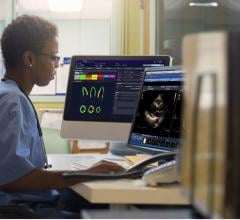
Physicians at the congenital heart center of Childrens Hospital saw a definite improvement in how they access and review congenital echo studies and generate reports.
OSF HealthCare System, owned and operated by The Sisters of the Third Order of St. Francis, Peoria, Ill., is a seven-hospital enterprise serving 2.5 million patients throughout Illinois and Michigan. With fragmented methods of managing and viewing images at each facility – some digital, some analog – and additional issues of a dictated report workflow, the health system needed standardization to meet its Mission of “serving others with the greatest care and love.” In 2006, OSF began adopting industry-leading enterprise medical imaging technology in the radiology department and, more recently, the cardiology department to provide instant access to images and reports across health care settings to accelerate diagnosis and treatment decisions.
Swimming in Boxes
“Because we had a mixed offering of different legacy systems and different levels of stabilization, guaranteeing system up-time was difficult, support was difficult, and ultimately, giving the best care to patients was difficult,” explains Todd Holling, manager of enterprise imaging systems/services at OSF HealthCare System. An area particularly challenged by manual processes was the echocardiogram labs across the facilities, which were swimming in boxes of VCR video tapes. The only way to access prior echos was to search through all of the boxes and, as a result, comparison with previous studies was seldom done.
Furthermore, all cardiologist reports were dictated, the verbiage was inconsistent and nobody was using structured reporting. The lack of standardized methodologies and tools to report and disseminate critical cardiovascular results led to report turnaround times in excess of 24 hours, delaying patient care decisions.
“Our goals were first and foremost to give patients the service they deserve, and second to stabilize system up-time,” says Holling. “We wanted to take the best in technology and move our organization forward.”
Seeing the Full Picture
In 2006, OSF determined that the Horizon Medical Imaging solution from McKesson was the best in picture archiving and communications system (PACS) technology. The system’s centralized database gives the organization the ability to standardize across facilities and to quickly bring new facilities live after acquisitions or mergers. For radiologists, the PACS streamlines their workflow by bringing everything they need onto one workstation with one worklist.
Two years later, the health system began searching for the best in cardiovascular information management technology. After a four-phase vendor evaluation process, the path led to McKesson and its Horizon Cardiology cardiovascular information system (CVIS).
“We evaluated clinical functionality, cost, integration and vendor ranking and narrowed [the choice] to two vendors,” says Steve Kastelein, cardiovascular PACS administrator at OSF HealthCare System. “We liked the idea of one vendor umbrella for both radiology and cardiology. Our enterprise-wide CVIS gives us a common architecture, single database solution, integrated into our EHR (electronic health record).”
Using Horizon Cardiology, cardiologists can capture, analyze, view and store cardiovascular images of any type and access the relevant information where it is needed to make the best clinical choices. The process has been enhanced by configuring wireless network bridges and laptops on the echo carts. These carts are wheeled into the patient’s room at the hospital where the images are taken and the sonographer completes a preliminary report on the attached laptop. This workflow provides the cardiologist with immediate access to the images and preliminary report, anywhere in
the enterprise.
In April 2010, OSF HealthCare System went live with the Horizon Cardiology CVIS in the congenital heart center of Children’s Hospital, where cardiologists report large gains in image management and reporting capabilities for their complex pediatric and congenital studies.
Jitendra Shah, M.D., professor of clinical pediatrics at University of Illinois College of Medicine and a pediatric cardiologist at OSF HealthCare System, has already seen definite improvement in how cardiologists access and review congenital echo studies and generate reports.
“Just today, a surgeon was putting in a shunt and called me from the operating room (OR) with a question,” relays Shah. “I was able to pull up the echo and the angio side by side in one system and show him in the OR. The CVIS definitely improves patient care.”
The system’s structured reporting capabilities also lead to improved patient care and safety across the health system’s cardiovascular departments and practices. Typically, a doctor dictates the report, a transcriptionist transcribes the report and then the physician must log into the RIS (radiology information system) and finalize the report. With a CVIS, the cardiologist can review, report and sign a study in any convenient location using the standardized tools in Horizon Cardiology, cutting out many steps, improving accuracy and allowing for trending. The structured data is also helpful in accreditation documentation for the echo and stress labs, because all physicians are using the Intersocietal Commission for the Accreditation of Echocardiography Laboratories (ICAEL)-compliant phrases.
“Structured reporting provides consistency in the reports, ensuring completeness and accuracy while providing rapid distribution and easy access for clinical staff and referring physicians,” adds Holling.
Getting Fast Results
After moving to McKesson’s CVIS, OSF HealthCare System eliminated 14 hours of transcription turnaround time, standardized reports across facilities and increased system up-time to 99.9 percent. After the typical initial skepticism of physicians, the system and structured reporting were quickly adopted. Within two weeks post-implementation, physician adoption reached 80 percent and climbed to 95 percent within 12 months. Cardiologist compliance is now at 99 percent for echo structured reports.
“Everybody likes the CVIS and the fact that you can now access images and reports from an outpatient clinic or from home,” Shah says. “McKesson has been extremely responsive to our needs, the comparison studies are a big advantage and the reports are more robust and easier to use.”
When cardiologists are happy, Kastelein is happy. “If you’re looking for an end-to-end cardiology information solution, a single-platform, single-database solution is powerful because it consistently provides the full patient story,” he says.
This case study was supplied by McKesson.



 May 15, 2024
May 15, 2024 








